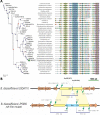A Stringent-Response-Defective Bradyrhizobium diazoefficiens Strain Does Not Activate the Type 3 Secretion System, Elicits an Early Plant Defense Response, and Circumvents NH4NO3-Induced Inhibition of Nodulation
- PMID: 33608284
- PMCID: PMC8091029
- DOI: 10.1128/AEM.02989-20
A Stringent-Response-Defective Bradyrhizobium diazoefficiens Strain Does Not Activate the Type 3 Secretion System, Elicits an Early Plant Defense Response, and Circumvents NH4NO3-Induced Inhibition of Nodulation
Abstract
When subjected to nutritional stress, bacteria modify their amino acid metabolism and cell division activities by means of the stringent response, which is controlled by the Rsh protein in alphaproteobacteria. An important group of alphaproteobacteria are the rhizobia, which fix atmospheric N2 in symbiosis with legume plants. Although nutritional stress is common for rhizobia while infecting legume roots, the stringent response has scarcely been studied in this group of soil bacteria. In this report, we obtained a mutant with a kanamycin resistance insertion in the rsh gene of Bradyrhizobium diazoefficiens, the N2-fixing symbiont of soybean. This mutant was defective for type 3 secretion system induction, plant defense suppression at early root infection, and nodulation competition. Furthermore, the mutant produced smaller nodules, although with normal morphology, which led to lower plant biomass production. Soybean (Glycine max) genes GmRIC1 and GmRIC2, involved in autoregulation of nodulation, were upregulated in plants inoculated with the mutant under the N-free condition. In addition, when plants were inoculated in the presence of 10 mM NH4NO3, the mutant produced nodules containing bacteroids, and GmRIC1 and GmRIC2 were downregulated. The rsh mutant released more auxin to the culture supernatant than the wild type, which might in part explain its symbiotic behavior in the presence of combined N. These results indicate that the B. diazoefficiens stringent response integrates into the plant defense suppression and regulation of nodulation circuits in soybean, perhaps mediated by the type 3 secretion system.IMPORTANCE The symbiotic N2 fixation carried out between prokaryotic rhizobia and legume plants performs a substantial contribution to the N cycle in the biosphere. This symbiotic association is initiated when rhizobia infect and penetrate the root hairs, which is followed by the growth and development of root nodules, within which the infective rhizobia are established and protected. Thus, the nodule environment allows the expression and function of the enzyme complex that catalyzes N2 fixation. However, during early infection, the rhizobia find a harsh environment while penetrating the root hairs. To cope with this nuisance, the rhizobia mount a stress response known as the stringent response. In turn, the plant regulates nodulation in response to the presence of alternative sources of combined N in the surrounding medium. Control of these processes is crucial for a successful symbiosis, and here we show how the rhizobial stringent response may modulate plant defense suppression and the networks of regulation of nodulation.
Keywords: plant defense; regulation of nodulation; stringent response; type 3 secretion system.
Copyright © 2021 American Society for Microbiology.
Figures





References
-
- Food and Agriculture Organization of the United Nations. 2020. http://www.fao.org/faostat/en/#data/QC. Accessed 15 January 2021.
Publication types
MeSH terms
Substances
Supplementary concepts
LinkOut - more resources
Full Text Sources
Other Literature Sources
Molecular Biology Databases

